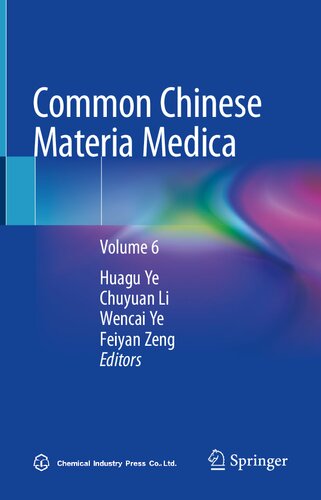Common Chinese Materia Medica: Volume 6 2022
دانلود کتاب پزشکی Materia Medica چینی رایج: جلد 6
| نویسنده |
Chuyuan Li, Feiyan Zeng, Huagu Ye, Wencai Ye |
|---|
| تعداد صفحهها |
598 |
|---|---|
| نوع فایل |
|
| حجم |
71 Mb |
| سال انتشار |
2022 |
89,000 تومان
این جلد ششم 226 گونه از 32 خانواده گیاهان دارویی را توصیف میکند که معمولاً در طب چینی استفاده میشوند. مهم ترین گونه ها Aquilaria sinensis و Daphne genkwa از Thymelaeaceae هستند. Benincasa hispida، Siraitia grosvenorii، Trichosanthes kirilowii، و Trichosanthes rosthornii کدوها هستند. Camellia sinensis از Theaceae; Cleistocalyx operculatus، Eugenia caryophyllata، و Rhodomyrtus tomentosa از Myrtaceae. Osbeckia chinensis از Melastomataceae. Quisqualis indica و Terminalia chebula از Combretaceae. Hypericum japonicum از Hypericaceae; Microcos paniculata از Tiliaceae. هیبیسکوس پخته شده از Malvaceae. Croton crassifolius، C. lachnocarpus، C. tiglium، Euphorbia humifusa، E. lathyris، E. pekinensis، Phyllanthus emblica و Sauropus spatulifolius از Euphorbiaceae.
در هر گونه، نامهای علمی، نامهای دارویی، تشکلها، زیستگاهها، پراکنشها، روشهای تهیه و فرآوری این گیاهان دارویی، محتوای خواص دارویی، اثرات درمانی، کاربرد و میزان مصرف این گیاهان دارویی. گیاهان ارائه شده است و عکس های رنگی و تصاویر قسمت هایی از داروهای گیاهی برای هر نوع پیوست شده است. .
این مجموعه کتاب در مجموع دارای 10 جلد است که بیش از 2000 نوع داروی رایج چینی را پوشش می دهد. این مجلدات نه تنها عملکرد اثربخشی و برخی نسخههای داروها، بلکه ویژگیهای بیولوژیکی آنها را با تصاویر واضحی از زیستگاهها به تفصیل ارائه میدهند تا خوانندگان بتوانند آنها را در میدان شناسایی کنند. جدا از محیط رو به رشد، کتاب ها مناطق توزیع و سایر اطلاعات را برای تسهیل تحقیق و سایر کاربردها توضیح می دهند. این مجلدات برای خوانندگان مورد علاقه عمومی است و برای محققان و مربیان ارزش مرجع بالایی دارد. این می تواند به عنوان یک راهنما برای محققان، پزشکان و دانشجویان در بخش فارماکولوژی و طب سنتی چینی استفاده شود.
This sixth volume describes 226 species of 32 families of medicinal plants, which are commonly used in Chinese medicine. The most important species are Aquilaria sinensis and Daphne genkwa of Thymelaeaceae; Benincasa hispida, Siraitia grosvenorii, Trichosanthes kirilowii and Trichosanthes rosthornii of Cucurbitaceae; Camellia sinensis of Theaceae; Cleistocalyx operculatus, Eugenia caryophyllata and Rhodomyrtus tomentosa of Myrtaceae; Osbeckia chinensis of Melastomataceae; Quisqualis indica and Terminalia chebula of Combretaceae; Hypericum japonicum of Hypericaceae; Microcos paniculata of Tiliaceae; Hibiscus mutabilis of Malvaceae; Croton crassifolius, C. lachnocarpus, C. tiglium, Euphorbia humifusa, E. lathyris, E. pekinensis, Phyllanthus emblica and Sauropus spatulifolius of Euphorbiaceae.
In each specie, it introduces the scientific names, medicinal names, morphologies, habitats, distributions, acquisition and processing methods of these medicinal plants, the content of medicinal properties, therapeutic effects, usage and dosage of these medicinal plants, and attaches unedited color pictures and pictures of part herbal medicines of each species.
This book series has 10 volumes in total, which covers over 2000 kinds of Chinese medicines that are commonly used. These volumes not only introduce the efficacy function and some prescriptions of the medicines, but also introduce the biological characteristics of them in detail with clear photos of the habitats, so that readers can identify them in the field. Apart from the growing environment, the books expound the distribution areas and other information to facilitate researches and other applications. The volumes are targeted at readers of general interests and it is also of high referential value for scientific researcher and teachers. It can be used as a guide to researchers, clinical doctors, and students in the department of pharmaceutics and traditional Chinese medicine.




